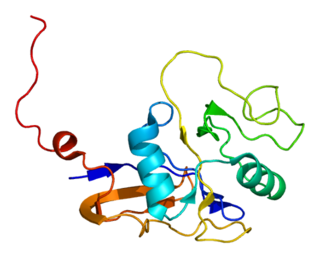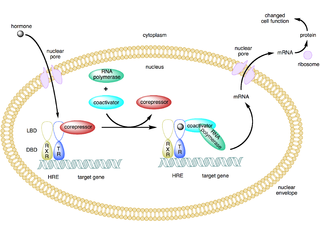Related Research Articles

Glycosaminoglycans (GAGs) or mucopolysaccharides are long linear polysaccharides consisting of repeating disaccharide units. Except for keratan, the repeating unit consists of an amino sugar, along with a uronic sugar or galactose. Because GAGs are highly polar and attract water, they are used in the body as a lubricant or shock absorber.

Selective estrogen receptor modulators (SERMs) are a class of drugs that act on the estrogen receptor (ER). A characteristic that distinguishes these substances from pure ER agonists and antagonists is that their action is different in various tissues, thereby granting the possibility to selectively inhibit or stimulate estrogen-like action in various tissues.

Hyaluronidases are a family of enzymes that catalyse the degradation of hyaluronic acid (HA). Karl Meyer classified these enzymes in 1971, into three distinct groups, a scheme based on the enzyme reaction products. The three main types of hyaluronidases are two classes of eukaryotic endoglycosidase hydrolases and a prokaryotic lyase-type of glycosidase.

Hyaluronic acid, also called hyaluronan, is an anionic, nonsulfated glycosaminoglycan distributed widely throughout connective, epithelial, and neural tissues. It is unique among glycosaminoglycans in that it is nonsulfated, forms in the plasma membrane instead of the Golgi apparatus, and can be very large: human synovial HA averages about 7 million Da per molecule, or about twenty thousand disaccharide monomers, while other sources mention 3–4 million Da. As one of the chief components of the extracellular matrix, hyaluronan contributes significantly to cell proliferation and migration, and may also be involved in the progression of some malignant tumors.

The CD44 antigen is a cell-surface glycoprotein involved in cell–cell interactions, cell adhesion and migration. In humans, the CD44 antigen is encoded by the CD44 gene on Chromosome 11. CD44 has been referred to as HCAM, Pgp-1, Hermes antigen, lymphocyte homing receptor, ECM-III, and HUTCH-1.

A coactivator is a type of transcriptional coregulator that binds to an activator to increase the rate of transcription of a gene or set of genes. The activator contains a DNA binding domain that binds either to a DNA promoter site or a specific DNA regulatory sequence called an enhancer. Binding of the activator-coactivator complex increases the speed of transcription by recruiting general transcription machinery to the promoter, therefore increasing gene expression. The use of activators and coactivators allows for highly specific expression of certain genes depending on cell type and developmental stage.

Receptor tyrosine kinases (RTKs) are the high-affinity cell surface receptors for many polypeptide growth factors, cytokines, and hormones. Of the 90 unique tyrosine kinase genes identified in the human genome, 58 encode receptor tyrosine kinase proteins. Receptor tyrosine kinases have been shown not only to be key regulators of normal cellular processes but also to have a critical role in the development and progression of many types of cancer. Mutations in receptor tyrosine kinases lead to activation of a series of signalling cascades which have numerous effects on protein expression. Receptor tyrosine kinases are part of the larger family of protein tyrosine kinases, encompassing the receptor tyrosine kinase proteins which contain a transmembrane domain, as well as the non receptor tyrosine kinases which do not possess transmembrane domains.

Endoglin (ENG) is a type I membrane glycoprotein located on cell surfaces and is part of the TGF beta receptor complex. It is also commonly referred to as CD105, END, FLJ41744, HHT1, ORW and ORW1. It has a crucial role in angiogenesis, therefore, making it an important protein for tumor growth, survival and metastasis of cancer cells to other locations in the body.

The sigma-2 receptor (σ2R) is a sigma receptor subtype that has attracted attention due to its involvement in diseases such as cancer and neurological diseases. It is currently under investigation for its potential diagnostic and therapeutic uses.

Free fatty acid receptor 1 (FFA1), also known as GPR40, is a class A G-protein coupled receptor that in humans is encoded by the FFAR1 gene. It is strongly expressed in the cells of the pancreas and to a lesser extent in the brain. This membrane protein binds free fatty acids, acting as a nutrient sensor for regulating energy homeostasis.

Complement component 1 Q subcomponent-binding protein, mitochondrial is a protein that in humans is encoded by the C1QBP gene.

Hyaluronan-binding protein 2 also known as factor VII activating protease (FSAP) is a protein that in humans is encoded by the HABP2 gene.

Hyaluronan-mediated motility receptor (HMMR), also known as RHAMM is a protein which in humans is encoded by the HMMR gene. RHAMM recently has been also designated CD168.

Hyaluronan synthase 2 is an enzyme that in humans is encoded by the HAS2 gene.

Lymphatic vessel endothelial hyaluronan receptor 1 (LYVE1), also known as extracellular link domain containing 1 (XLKD1) is a Link domain-containing hyaladherin, a protein capable of binding to hyaluronic acid (HA), homologous to CD44, the main HA receptor. In humans it is encoded by the LYVE1 gene.

Tumor necrosis factor-inducible gene 6 protein also known as TNF-stimulated gene 6 protein or TSG-6 is a protein that in humans is encoded by the TNFAIP6 gene.

Stabilin-2 is a protein that in humans is encoded by the STAB2 gene.

Sodium hyaluronate is the sodium salt of hyaluronic acid, a glycosaminoglycan found in various connective tissue of humans.
Folate targeting is a method utilized in biotechnology for drug delivery purposes. This Trojan Horse process, which was created by Drs. Christopher P. Leamon and Philip S. Low, involves the attachment of the vitamin, folate, to a molecule/drug to form a "folate conjugate". Based on the natural high affinity of folate for the folate receptor protein (FR), which is commonly expressed on the surface of many human cancers, folate-drug conjugates also bind tightly to the FR and trigger cellular uptake via endocytosis. Molecules as diverse as small radiodiagnostic imaging agents to large DNA plasmid formulations have successfully been delivered inside FR-positive cells and tissues.

A Link domain or Link module, also known as Xlink domain, is a protein domain that binds to hyaluronic acid. It is important in blood cell migration and apoptosis. The link domain is found in some extracellular proteins in vertebrates such as the hyalectans. It appears to be involved in extracellular matrix assembly and stability, cell adhesion, and migration.
References
- ↑ Toole, B.P. (October 1990). "Hyaluronan and its binding proteins, the hyaladherins". Current Opinion in Cell Biology. 2 (5): 839–844. doi:10.1016/0955-0674(90)90081-O.
- 1 2 Day, A. J.; Prestwich, G. D. (20 November 2001). "Hyaluronan-binding Proteins: Tying Up the Giant". Journal of Biological Chemistry. 277 (7): 4585–4588. doi: 10.1074/jbc.R100036200 . PMID 11717315.
- ↑ Nikitovic, Dragana; Kouvidi, Katerina; Kavasi, Rafaela-Maria; Berdiaki, Aikaterini; N. Tzanakakis, George (21 May 2016). "Hyaluronan/Hyaladherins - a Promising Axis for Targeted Drug Delivery in Cancer". Current Drug Delivery. 13 (4): 500–511. doi:10.2174/1567201813666151109103013.